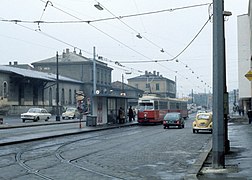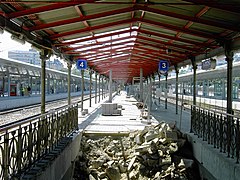Eichenstrasse (Vienna)
| Oak Street | |
|---|---|
| Street in Vienna | |
| Basic data | |
| place | Vienna |
| District | 12th district |
| Created | 1894 |
| Hist. Names | Dam road |
| Connecting roads | Fendigasse, Edelsinnstrasse |
| Cross streets | Margaretengürtel, Wolfganggasse, Fockygasse, Malfattigasse, Hanauskagasse, Längenfeldgasse , Rottmayrgasse, Aßmayergasse , Steinackergasse, Dörfelstrasse, Hoffmeistergasse, Wilhelmstrasse, Meidlinger Hauptstrasse |
| Buildings | Vienna Meidling train station |
| use | |
| User groups | Pedestrians , bicycle traffic , car traffic , local railway Vienna – Baden , tram line 62, bus lines 8A 9A 59A 62A |
| Technical specifications | |
| Street length | approx. 1557 m |
The Oak Street is located in the 12th Vienna district, Meidling . It is part of the former B12 federal highway , which in Vienna also includes Breitenfurter Strasse and Brunner Strasse.
Course and characteristics
The Eichenstraße runs from east to west along the Südbahn route or the ÖBB - Betriebsanlagen Wien Matzleinsdorf (on the site of the former freight station Matzleinsdorf) from the Margaretengürtel to the Philadelphiabrücke . It continues to the west on Edelsinnstrasse. The Eichenstraße is crossed by the Längenfeldgasse , at its western end the Meidlinger Hauptstraße , the Wilhelmstraße and the street Eichenstraße / Edelsinnstraße form the northern part of the traffic junction at the Philadelphiabrücke.
At the eastern end of the street on the northern side of the street was the Wolfganggasse depot of the local railway Vienna – Baden . From here, the trains of the Badner Bahn turned into Eichenstrasse and drove them over a length of about 1400 m to the Philadelphiabrücke. Since 2018, it has only been running on the same tracks that are used by tram line 62 (from Dörfelstraße to the west).
Near the western end of the road, in Philadelphia bridge, there are an eponymous metro station of metro line U6 and the ÖBB - Vienna Meidling station , from 2009 to 2014 because of the construction of the new Vienna Central Station starting point of the passenger traffic of the southern runway and constantly Stop of several rapid transit lines . The bus lines 8A, 9A, 59A and 62A of Wiener Linien have their terminus at these two traffic points, but otherwise do not use Eichenstrasse.
Eichenstrasse is characterized on its south side exclusively by buildings in connection with the southern runway. The northern side consists largely of residential buildings that were built after 1945.
history
The original name of Eichenstrasse was Dammstrasse, after the railway embankment running parallel to it. In 1894 it was named Eichenstrasse after two oaks at the confluence of Wilhelmstrasse and Eichenstrasse, where there were also Marterln . The area used to belong to the villages Wilhelmsdorf and Untermeidling , the easternmost part of the street belonged to the 5th district, Margareten (district part Neu-Margareten) until 1907 .
During the civil war in February 1934, Eichenstrasse played an important role, as this was where the first victims fell. On February 12, the policeman Josef Schiel, who tried to stop an armed worker, was shot dead by him. In a subsequent demonstration, which was supposed to be broken up by the police, rifle shots were fired at the executive, who had to retreat. Armed members of the Republican Protection Association occupied numerous locations in Meidling and set up defense posts along Eichenstrasse from the Matzleinsdorf freight station to the Meidlinger station, which was also occupied. Only with the reinforcement of the armed forces and the deployment of an armored train did the police manage to recapture the station.
From the intersection area with the Längenfeldgasse was Meidlinger Hofküchenwasserleitung to Schonbrunn Palace headed.
Notable buildings
At the eastern end of Eichenstrasse on the northern side of the street is the former Badner Bahn depot with its former Wolfganggasse station (until 2018). After the Badner Bahn has moved away, the area is to be re-used as an urban development area, whereby the historic railway building is to be retained. Next to it, on the corner of Wolfganggasse 58–60, is the former company building of the First Lower Austrian Workers Consuming Association , which was built by Franz and Hubert Gessner in the years 1898–1909 .
No. 5 to 23: Workers' houses
In connection with the Meidlinger Bahnhof are the workers' houses built in Eichenstrasse 5–23 around 1870 according to plans by Wilhelm Flattich , the exterior of which has been preserved almost unchanged. (As director of structural engineering for the Südbahngesellschaft , Flattich had also built the Vienna Südbahnhof and other buildings along the route.) This is an example of an early social housing project in which apartments were created in ten three-story workers' houses for the employees of the Südbahngesellschaft. On the courtyard side, facing the railway tracks, gardens were laid out for the children to play. The brick buildings were relatively unadorned, only structured by cordon and cornice cornices.
These buildings are under monument protection. By autumn 2015 they were converted into 152 apartments while retaining the façade and have been used as student dormitories ever since.
No. 16 to 22
Here, in 1875/1876, the architect C. Bringmann built six non-contiguous, Swiss-style semi-detached houses on the side and back of the Aßmayergasse 67–73, Murlingengasse 33–39 and Rottmayrgasse 20–26 block of houses. Turning to Murlingengasse, you will find a remarkable relief of Mary with child from the construction period.
No. 25: Vienna Meidling train station
The station building, demolished before 2009, was the last to be preserved from the time when the Vienna – Gloggnitz Railway opened in 1841 . The administration building was two-story and still had the original structure of the pilaster strips ; It was connected to the station building with the original attic by a ground-level connecting building. From around 1900 came a pedestrian underpass with tile cladding, the staircases, bars and platform roofs.
In the station building there was a small private chapel that was looked after by the Sisters of the Cross . The sisters also lived in the station and looked after the children of the railway employees. In 1904 they moved to the newly built monastery building at Murlingengasse 71.
In 1841, the Meidlinger Bahnhof was a transit station with no other rail connections, but was only a 2nd class station in the ranking of the Südbahngesellschaft. In 1860, Meidling became a crossing station with the construction of the connecting line that connected the southern and western lines. In 1875 the Pottendorfer line finally met the southern railway line here. These changes, as well as the gradual expansion of the Matzleinsdorfer freight station to Meidling station and the opening of the rapid transit lines in 1962 and the Philadelphiabrücke underground station , now Meidling station, in 1989 finally made it the busiest station in Vienna. By 2009 the station was completely renewed and redesigned in order to be able to replace the southern station, which was demolished in 2010, until the long-distance tracks of the new main station were opened in 2014/2015. Since December 13, 2015, the Vienna Meidling station has been a fixed stopping point for all ÖBB long-distance trains that come into contact with Vienna, which have been running to the main station since that day.
No. 50 and 52
A workers' home was once located here. On the new post-war building there is a natural stone relief, Der Wassergeist von Wilhelmsdorf , from 1955 by Josef Schagerl. It reminds of the legend of Wilhelmsdorfer Wassermann, who is said to have lived in the brick ponds that used to be here.
literature
- Felix Czeike (Ed.): Eichenstrasse. In: Historisches Lexikon Wien . Volume 2, Kremayr & Scheriau, Vienna 1993, ISBN 3-218-00544-2 , p. 140 ( digitized version ).
- Dehio Handbook Vienna. X. to XIX. and XXI. to XXIII. District . Publisher Anton Schroll: Vienna 1996
Web links
Individual evidence
- ↑ Everything new in the old house. In: bz Wiener Bezirkszeitung Edition Meidling, ZDB -ID 2632446-5 . No. 32, 5th / 6th August 2015. pp. 12–13.
Coordinates: 48 ° 10 ′ 35.8 " N , 16 ° 20 ′ 27.2" E
























